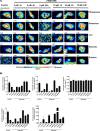Synchrotron-based X-ray fluorescence microscopy reveals accumulation of polymyxins in single human alveolar epithelial cells
- PMID: 33649114
- PMCID: PMC8092916
- DOI: 10.1128/AAC.02314-20
Synchrotron-based X-ray fluorescence microscopy reveals accumulation of polymyxins in single human alveolar epithelial cells
Abstract
Intravenous administration of the last-line polymyxins results in poor drug exposure in the lungs and potential nephrotoxicity; while inhalation therapy offers better pharmacokinetics/pharmacodynamics for pulmonary infections by delivering the antibiotic to the infection site directly. However, polymyxin inhalation therapy has not been optimized and adverse effects can occur. This study aimed to quantitatively determine the intracellular accumulation and distribution of polymyxins in single human alveolar epithelial A549 cells. Cells were treated with an iodine-labeled polymyxin probe FADDI-096 (5.0 and 10.0 μM) for 1, 4, and 24 h. Concentrations of FADDI-096 in single A549 cells were determined by synchrotron-based X-ray fluorescence microscopy. Concentration- and time-dependent accumulation of FADDI-096 within A549 cells was observed. The intracellular concentrations (mean ± SEM, n ≥ 189) of FADDI-096 were 1.58 ± 0.11, 2.25 ± 0.10, and 2.46 ± 0.07 mM following 1, 4 and 24 h of treatment at 10 μM, respectively. The corresponding intracellular concentrations following the treatment at 5 μM were 0.05 ± 0.01, 0.24 ± 0.04, and 0.25 ± 0.02 mM (n ≥ 189). FADDI-096 was mainly localized throughout the cytoplasm and nuclear region over 24 h. The intracellular zinc concentration increased in a concentration- and time-dependent manner. This is the first study to quantitatively map the accumulation of polymyxins in human alveolar epithelial cells and provides crucial insights for deciphering the mechanisms of their pulmonary toxicity. Importantly, our results may shed light on the optimization of inhaled polymyxins in patients and the development of new-generation safer polymyxins.
Copyright © 2021 American Society for Microbiology.
Figures




Similar articles
-
Transcriptomic Responses to Polymyxin B and Analogues in Human Kidney Tubular Cells.Antibiotics (Basel). 2023 Feb 20;12(2):415. doi: 10.3390/antibiotics12020415. Antibiotics (Basel). 2023. PMID: 36830325 Free PMC article.
-
Intracellular localization of polymyxins in human alveolar epithelial cells.J Antimicrob Chemother. 2019 Jan 1;74(1):48-57. doi: 10.1093/jac/dky409. J Antimicrob Chemother. 2019. PMID: 30357331 Free PMC article.
-
Significant accumulation of polymyxin in single renal tubular cells: a medicinal chemistry and triple correlative microscopy approach.Anal Chem. 2015 Feb 3;87(3):1590-5. doi: 10.1021/ac504516k. Epub 2015 Jan 15. Anal Chem. 2015. PMID: 25553489 Free PMC article.
-
New polymyxin derivatives that display improved efficacy in animal infection models as compared to polymyxin B and colistin.Med Res Rev. 2018 Sep;38(5):1661-1673. doi: 10.1002/med.21494. Epub 2018 Feb 27. Med Res Rev. 2018. PMID: 29485690 Review.
-
Shifting Gears: The Future of Polymyxin Antibiotics.Antibiotics (Basel). 2019 Apr 12;8(2):42. doi: 10.3390/antibiotics8020042. Antibiotics (Basel). 2019. PMID: 31013818 Free PMC article. Review.
Cited by
-
Tobramycin Reduces Pulmonary Toxicity of Polymyxin B via Inhibiting the Megalin-Mediated Drug Uptake in the Human Lung Epithelial Cells.Pharmaceutics. 2024 Mar 12;16(3):389. doi: 10.3390/pharmaceutics16030389. Pharmaceutics. 2024. PMID: 38543283 Free PMC article.
-
Polymyxin Induces Significant Transcriptomic Perturbations of Cellular Signalling Networks in Human Lung Epithelial Cells.Antibiotics (Basel). 2022 Feb 24;11(3):307. doi: 10.3390/antibiotics11030307. Antibiotics (Basel). 2022. PMID: 35326770 Free PMC article.
-
Genome-scale metabolic modeling in antimicrobial pharmacology.Eng Microbiol. 2022 Apr 23;2(2):100021. doi: 10.1016/j.engmic.2022.100021. eCollection 2022 Jun. Eng Microbiol. 2022. PMID: 39628842 Free PMC article. Review.
-
Polymyxin-Induced Metabolic Perturbations in Human Lung Epithelial Cells.Antimicrob Agents Chemother. 2021 Aug 17;65(9):e0083521. doi: 10.1128/AAC.00835-21. Epub 2021 Aug 17. Antimicrob Agents Chemother. 2021. PMID: 34228550 Free PMC article.
-
The use of synchrotron X-ray fluorescent imaging to study distribution and content of elements in chemically fixed single cells: a case study using mouse pancreatic beta-cells.Metallomics. 2023 Feb 16;15(2):mfad006. doi: 10.1093/mtomcs/mfad006. Metallomics. 2023. PMID: 36737500 Free PMC article.
References
-
- World Health Organization (WHO). 2018. Global antimicrobial resistance surveillance system (GLASS) report: early implementation 2017–2018. World Health Organization, Geneva, Switzerland.
-
- Ahern S, Tacey M, Esler M, Oldroyd J, Dean J, Bell B. 2017. The Australian cystic fibrosis data registry annual report 2015. Monash University, Department of Epidemiology and Preventive Medicine, Melbourne, Australia.
-
- Centers for Disease Control and Prevention. 2019. Antibiotic resistance threats in the United States, 2019. Department of Health and Human Services, Centers for Disease Control and Prevention, Atlanta, GA.
-
- Boucher HW, Talbot GH, Benjamin DK, Jr, Bradley J, Guidos RJ, Jones RN, Murray BE, Bonomo RA, Gilbert D, Infectious Diseases Society of America.. 2013. 10 × ’20 progress—development of new drugs active against gram-negative bacilli: an update from the Infectious Diseases Society of America. Clin Infect Dis 56:1685–1694. 10.1093/cid/cit152. - DOI - PMC - PubMed
-
- Theuretzbacher U, Gottwalt S, Beyer P, Butler M, Czaplewski L, Lienhardt C, Moja L, Paul M, Paulin S, Rex JH, Silver LL, Spigelman M, Thwaites GE, Paccaud JP, Harbarth S. 2019. Analysis of the clinical antibacterial and antituberculosis pipeline. Lancet Infect Dis 19:e40–e50. 10.1016/S1473-3099(18)30513-9. - DOI - PubMed
Grants and funding
LinkOut - more resources
Full Text Sources
Other Literature Sources

